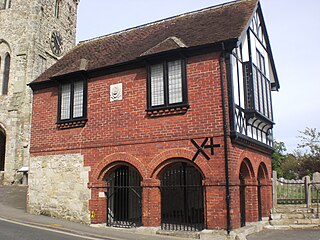
Midhurst is a market town and civil parish in the Chichester District in West Sussex, England. It lies on the River Rother, 20 miles (30 km) inland from the English Channel and 12 miles (19 km) north of Chichester.

Bremen City Hall is the seat of the President of the Senate and Mayor of Bremen, Germany. It is one of the most important examples of Brick Gothic and Weser Renaissance architecture in Europe. Since 1973, it has been a protected historical building. In July 2004, along with the Bremen Roland statue, the building was added to the list of UNESCO World Heritage Sites because of its outstanding architecture and its testimony to the development of civic autonomy in the Holy Roman Empire.

Wetherby Town Hall is a community building in Wetherby, West Yorkshire, England. The town hall no longer plays a major civic function but provides an office which is used by Wetherby Town Council and facilities for local groups and events. It is a Grade II listed building.

Alton Town Hall is a municipal building in the Market Square in Alton, Hampshire, England. The structure, which is the meeting place of Alton Town Council, is a Grade II listed building.

Dursley Town Hall, also known as Dursley Market Hall, is a municipal building in the Market Place, Dursley, Gloucestershire, England. The structure, which is mainly used for markets and community events, is a Grade II* listed building.

Marlow Town Hall is a municipal building in the Market Square, Marlow, Buckinghamshire, England. The structure, which was used as a public events venue, is a Grade II* listed building.

Camelford Town Hall is a municipal building in the Market Place, Camelford, Cornwall, England. The town hall, which is currently used as a public library, is a Grade II listed building.

Garstang Town Hall is a municipal building in the High Street in Garstang, Lancashire, England. The structure, which currently accommodates two shops and a Royal British Legion Club, is a Grade II listed building.

Helmsley Town Hall is a municipal building in the Market Place in Helmsley, North Yorkshire, England. The structure, which is used as a community library and a community events centre, is a grade II listed building.

The Old Town Hall is a municipal building in the Market Place in Faringdon, Oxfordshire, England. The building, which is used as an exhibitions and events venue, is a Grade II* listed building.

Bampton Town Hall is a municipal building in the Market Square in Bampton, Oxfordshire, England. The building, which is primarily used as an arts centre, is a Grade II listed building.

Clun Town Hall is a municipal building in The Square in Clun, Shropshire, England. The building, which is now used as a museum, is a Grade II* listed building.

Dulverton Town Hall is a municipal building in Fore Street in Dulverton, Somerset, England. The building, which is the meeting place of Dulverton Town Council, is a Grade II listed building.

Leconfield Hall, formerly Petworth Town Hall, is a municipal building in the Market Square in Petworth, West Sussex, England. The building, which is now used as a cinema, is a Grade II* listed building.

The Old Town Hall is a municipal building in The High Street in Steyning, West Sussex, England. The building, which was used as a courthouse and a public events venue, is a Grade II listed building.

The Cheese Market in Hay-on-Wye, formerly Hay-on-Wye Town Hall,, is a municipal building in Market Street, Hay-on-Wye, Powys, Wales. The structure, which has been restored with support from the Heritage Lottery Fund so that the first floor can be let out for residential use, is a Grade II listed building.

The Assembly Rooms in Presteigne, formerly Presteigne Town Hall, is a municipal building in Broad Street, Presteigne, Powys, Wales. The structure, which accommodates a public library on the ground floor and an arts centre on the first floor, is a Grade II listed building.

Ballynahinch Market House, formerly known as Ballynahinch Court House and as Ballynahinch Town Hall, is a municipal structure in the Market Square, Ballynahinch, County Down, Northern Ireland. The structure, which is used as a community events venue, is a Grade B1 listed building.

The Old Town Hall is a municipal building in the High Street, Brading, Isle of Wight, England. The structure, which is now used to store and exhibition a collection of artefacts and records, is a Grade II listed building.

Bradninch Guildhall is a municipal building in Fore Street, Bradninch, Devon, England. The structure, which is now used as a community events venue, is a Grade II listed building.






















